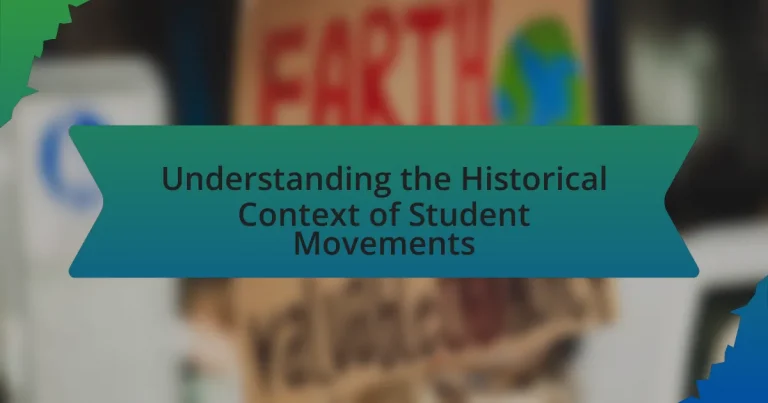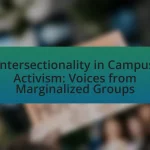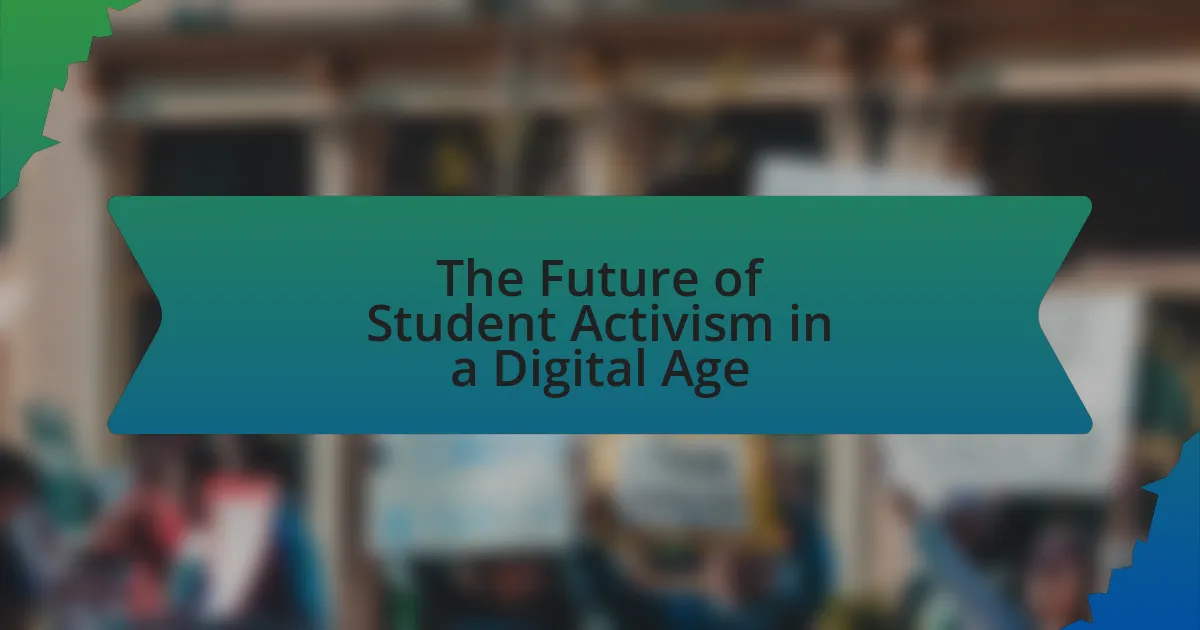Student movements are organized efforts by students advocating for social, political, or educational change, often in response to perceived injustices. Historically significant events, such as the Civil Rights Movement and the May 1968 protests in France, illustrate the impact of student activism on societal norms and policies. The evolution of these movements reflects a shift from localized protests to global activism, influenced by socio-economic conditions and technological advancements. Key characteristics include collective organization and a focus on equity and inclusion, with strategies ranging from protests to digital organizing. Understanding the historical context of student movements reveals their crucial role in shaping public policy and fostering social justice.
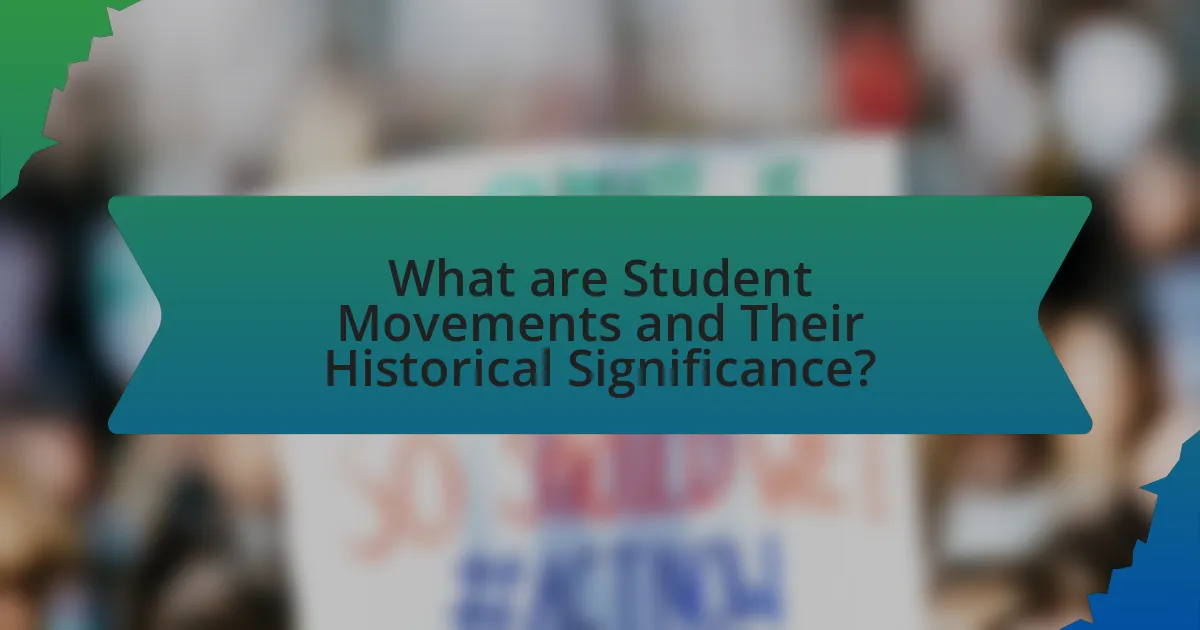
What are Student Movements and Their Historical Significance?
Student movements are organized efforts by students to advocate for social, political, or educational change, often emerging in response to perceived injustices or systemic issues. Historically, these movements have played a crucial role in shaping societal norms and policies; for instance, the 1960s civil rights movement in the United States saw significant student involvement, leading to legislative changes such as the Civil Rights Act of 1964. Additionally, the May 1968 protests in France highlighted the power of student activism in challenging authority and promoting progressive reforms, influencing global youth culture and political discourse. These movements demonstrate the capacity of students to mobilize for change, impacting both local and international contexts.
How have student movements evolved over time?
Student movements have evolved from localized protests focused on specific issues to global movements addressing broader social, political, and environmental concerns. Initially, in the early 20th century, student activism primarily centered around national issues, such as anti-war sentiments during World War I and civil rights in the 1960s, exemplified by the Free Speech Movement at the University of California, Berkeley. Over time, the scope of these movements expanded, particularly with the advent of the internet, allowing for rapid dissemination of information and coordination across borders. For instance, the Arab Spring in 2011 saw students mobilizing through social media to demand democratic reforms, illustrating a shift towards transnational activism. This evolution reflects a growing awareness among students of global interconnectedness and the impact of local actions on worldwide issues, such as climate change and social justice.
What key historical events influenced the rise of student movements?
Key historical events that influenced the rise of student movements include the Civil Rights Movement, the Vietnam War protests, and the May 1968 protests in France. The Civil Rights Movement, particularly in the United States during the 1950s and 1960s, mobilized students to advocate for racial equality and social justice, exemplified by the formation of groups like the Student Nonviolent Coordinating Committee. The Vietnam War protests, especially in the late 1960s, saw widespread student activism against U.S. military involvement, with significant demonstrations occurring on college campuses, highlighting the role of youth in political dissent. Additionally, the May 1968 protests in France galvanized students and workers alike, leading to a nationwide strike and challenging the existing social order, which inspired similar movements globally. These events collectively shaped the political consciousness of students, fostering a culture of activism that persists today.
How did global political climates shape student activism?
Global political climates significantly shaped student activism by influencing the issues students prioritized and the methods they employed for advocacy. For instance, during the Cold War, students in various countries mobilized against nuclear weapons and imperialism, reflecting the geopolitical tensions of the era. In the 1960s, the civil rights movement in the United States inspired global student protests, as students sought to address social injustices and demand political reforms. Additionally, the rise of authoritarian regimes in Latin America and Eastern Europe prompted students to organize protests against oppressive governments, as seen in the Tiananmen Square protests in China in 1989, where students demanded democratic reforms. These examples illustrate how the prevailing political environment directly impacted the focus and intensity of student activism across different regions and historical periods.
Why are student movements important in societal change?
Student movements are crucial for societal change because they mobilize young people to advocate for social justice, political reform, and educational improvements. Historically, student movements have played a significant role in shaping public policy and influencing national discourse, as seen during the Civil Rights Movement in the United States, where students organized protests and sit-ins that were pivotal in challenging segregation laws. Additionally, the 1968 student protests in France exemplified how collective action can lead to widespread societal shifts, resulting in changes to labor laws and educational reforms. These movements often serve as catalysts for broader societal awareness and engagement, demonstrating the power of youth activism in driving change.
What role do students play in advocating for social justice?
Students play a crucial role in advocating for social justice by mobilizing communities, raising awareness, and influencing policy changes. Historically, student movements have been at the forefront of significant social justice campaigns, such as the Civil Rights Movement in the 1960s, where students organized protests and sit-ins to challenge racial segregation. Their ability to leverage social media and grassroots organizing allows them to effectively communicate issues and rally support, as seen in recent movements like Black Lives Matter and climate activism. Research indicates that student-led initiatives can lead to tangible policy changes, demonstrating their impact on social justice advocacy.
How have student movements impacted educational policies?
Student movements have significantly influenced educational policies by advocating for reforms that address issues such as access, equity, and curriculum changes. For instance, the civil rights movement in the 1960s led to the implementation of policies aimed at desegregating schools and increasing funding for historically marginalized institutions. Additionally, the student protests during the Vietnam War era prompted universities to reconsider their roles in society, resulting in the establishment of more inclusive governance structures and the incorporation of student voices in decision-making processes. These movements have historically pressured policymakers to respond to the demands for greater representation and social justice within educational systems, leading to lasting changes in policy frameworks.
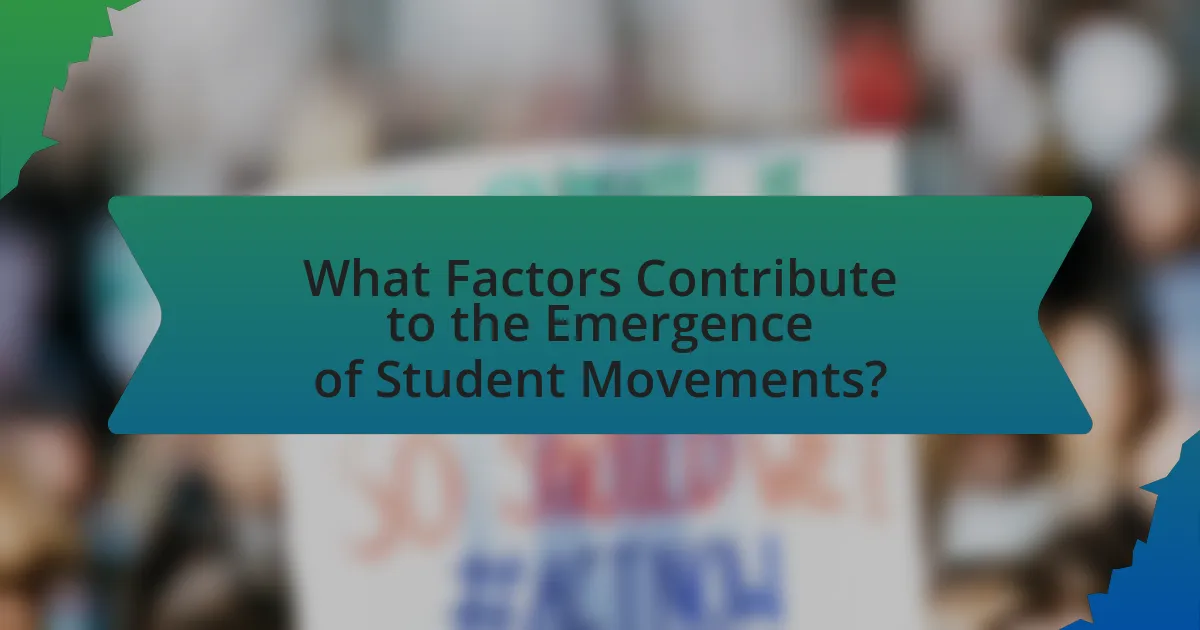
What Factors Contribute to the Emergence of Student Movements?
Student movements emerge due to a combination of political, social, and economic factors. Political repression, such as authoritarian regimes limiting freedoms, often galvanizes students to mobilize for change. Social issues, including inequality and discrimination, can also drive students to advocate for justice and reform. Economic factors, such as rising tuition costs and unemployment, create discontent among students, prompting collective action. Historical examples include the 1960s civil rights movement in the United States, where students played a crucial role in advocating for racial equality, and the 1989 Tiananmen Square protests in China, which were fueled by demands for political reform and greater freedoms. These factors collectively create an environment ripe for the emergence of student movements.
How do socio-economic conditions influence student activism?
Socio-economic conditions significantly influence student activism by shaping the priorities, motivations, and capabilities of students to engage in collective action. For instance, students from lower socio-economic backgrounds often face financial constraints that can drive them to advocate for affordable education and social justice, as seen in movements like the 2011 Quebec student protests, where rising tuition fees prompted widespread activism. Additionally, socio-economic disparities can lead to heightened awareness of inequality, motivating students to organize around issues such as labor rights and racial justice, as evidenced by the involvement of students in the Civil Rights Movement during the 1960s. Thus, the socio-economic context not only informs the issues students choose to address but also affects their ability to mobilize resources and support for their causes.
What economic factors have historically sparked student protests?
Economic factors that have historically sparked student protests include rising tuition fees, student debt burdens, and economic inequality. For instance, the 1960s protests in the United States were significantly influenced by the increasing costs of higher education, which made college less accessible to lower-income students. Additionally, the 2011 protests in Chile were driven by demands for free education, highlighting the impact of privatization and economic disparities in access to education. These events illustrate how economic pressures can mobilize students to advocate for systemic change.
How does access to education affect student mobilization?
Access to education significantly enhances student mobilization by equipping individuals with critical thinking skills and awareness of social issues. When students have access to quality education, they are more likely to engage in civic activities and advocate for change, as evidenced by historical movements such as the Civil Rights Movement in the United States, where educated youth played pivotal roles in organizing protests and raising awareness. Furthermore, studies indicate that higher levels of education correlate with increased political participation; for instance, a report by the Pew Research Center found that college-educated individuals are more likely to vote and participate in activism compared to those with lower educational attainment. Thus, access to education serves as a catalyst for student mobilization, fostering informed and active citizens.
What role does technology play in modern student movements?
Technology plays a crucial role in modern student movements by facilitating communication, organization, and mobilization. Digital platforms such as social media enable students to share information rapidly, coordinate protests, and raise awareness about issues like climate change and social justice. For instance, the #FridaysForFuture movement, initiated by Greta Thunberg, utilized Twitter and Instagram to galvanize global youth participation in climate strikes, demonstrating how technology can amplify voices and foster solidarity across borders. Additionally, tools like online petitions and crowdfunding platforms have empowered students to advocate for change and secure resources for their causes, further illustrating technology’s impact on the effectiveness and reach of student activism.
How has social media changed the landscape of student activism?
Social media has transformed student activism by providing a platform for rapid communication, mobilization, and awareness-raising. This shift allows students to organize protests, share information, and amplify their voices on a global scale, as evidenced by movements like #BlackLivesMatter and #MeToo, which gained traction through platforms such as Twitter and Instagram. Research indicates that social media enables real-time engagement and fosters community building among activists, leading to increased participation and visibility for social justice issues. For instance, a study published in the Journal of Youth Studies highlights that 70% of young activists reported using social media to connect with like-minded individuals and coordinate actions, demonstrating its pivotal role in modern student movements.
What are the implications of digital organizing for student movements?
Digital organizing significantly enhances student movements by facilitating rapid communication, mobilization, and coordination among participants. This immediacy allows students to organize protests, share information, and rally support more effectively than traditional methods. For instance, the use of social media platforms during the 2011 Occupy Wall Street movement demonstrated how digital tools could amplify voices and connect diverse groups, leading to a larger, more unified front. Additionally, research indicates that digital organizing can lower barriers to participation, enabling a broader demographic of students to engage in activism, as seen in the global climate strikes initiated by youth activists like Greta Thunberg. These implications underscore the transformative role of digital organizing in shaping contemporary student movements.
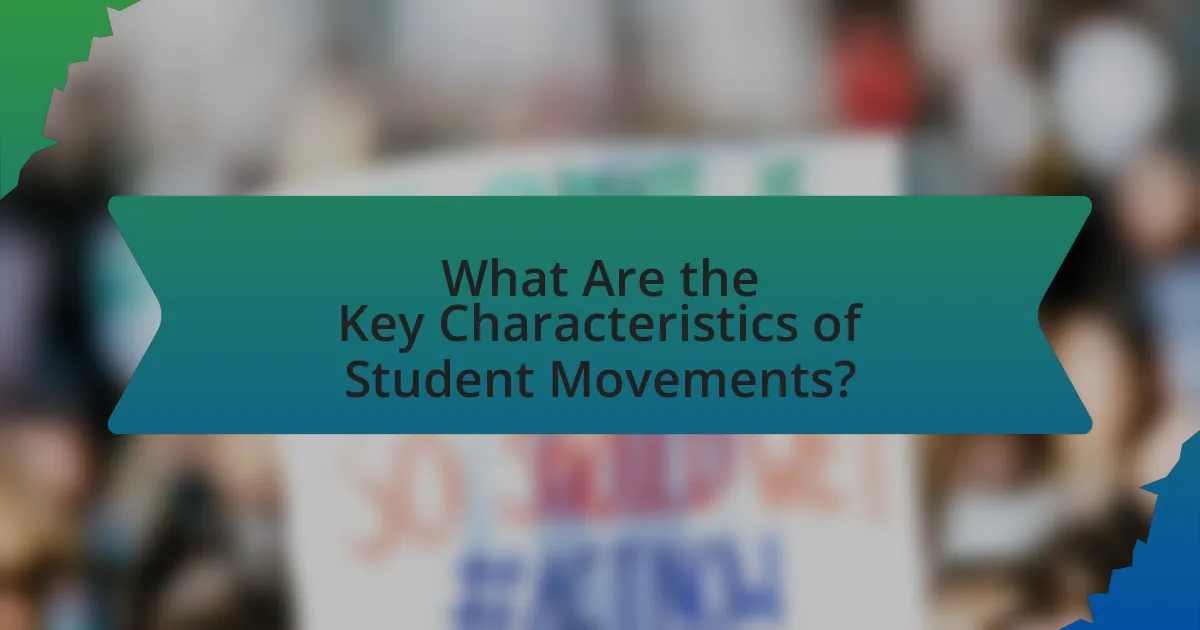
What Are the Key Characteristics of Student Movements?
Key characteristics of student movements include activism, collective organization, and a focus on social or political change. Activism is often driven by issues such as educational reform, civil rights, or anti-war sentiments, as seen in movements like the 1960s civil rights protests in the United States. Collective organization typically involves student groups or associations that mobilize members to advocate for their causes, exemplified by the formation of the Student Nonviolent Coordinating Committee (SNCC) during the civil rights movement. Additionally, student movements often utilize various forms of protest, including demonstrations, sit-ins, and online campaigns, to raise awareness and influence public opinion, as demonstrated by the global climate strikes initiated by students in 2019. These characteristics highlight the role of students as active participants in societal change throughout history.
What common goals do student movements typically pursue?
Student movements typically pursue goals such as educational reform, social justice, and political activism. These movements often aim to address issues like tuition fees, curriculum changes, and the democratization of educational institutions. For instance, the 1960s student protests in the United States focused on civil rights and opposition to the Vietnam War, highlighting the intersection of education and broader societal issues. Additionally, contemporary student movements, such as those advocating for climate action, demonstrate a continued commitment to social responsibility and activism.
How do student movements address issues of equity and inclusion?
Student movements address issues of equity and inclusion by advocating for marginalized groups and promoting policies that ensure equal access to education and resources. For instance, movements such as the Civil Rights Movement in the 1960s saw students actively participating in protests and sit-ins to challenge segregation and discrimination in schools. Additionally, contemporary student organizations often focus on issues like racial justice, gender equality, and rights, pushing universities to implement inclusive practices and curricula. Research indicates that student activism has led to significant policy changes, such as the establishment of diversity offices and the inclusion of multicultural education in academic programs, thereby reinforcing the importance of equity and inclusion in educational institutions.
What strategies do student movements use to achieve their objectives?
Student movements utilize various strategies to achieve their objectives, including organizing protests, engaging in advocacy, and forming coalitions. Protests serve as a visible demonstration of dissent, often drawing media attention and public support, as seen in the 1960s civil rights movement where student-led marches significantly influenced legislation. Advocacy efforts involve lobbying policymakers and raising awareness about specific issues, exemplified by the student activism surrounding climate change, which has mobilized millions globally. Additionally, forming coalitions with other organizations amplifies their voice and resources, as demonstrated by the collaboration between student groups and labor unions during the anti-war protests in the 1970s. These strategies collectively enhance the effectiveness of student movements in pursuing their goals.
How do student movements differ across cultures and regions?
Student movements differ across cultures and regions primarily in their motivations, methods, and societal impacts. In Western countries, such as the United States and France, student movements often focus on issues like civil rights, anti-war protests, and educational reforms, exemplified by the 1968 student protests in Paris, which aimed to challenge authority and promote social change. In contrast, student movements in regions like Asia, particularly in countries such as China and Vietnam, have historically been more focused on political reform and national identity, as seen in the Tiananmen Square protests of 1989, where students demanded democratic reforms and greater freedoms. Additionally, cultural factors influence the organization and expression of these movements; for instance, collectivist societies may emphasize group solidarity and collective action, while individualistic cultures may highlight personal expression and dissent. These differences illustrate how local contexts shape the nature and goals of student activism globally.
What unique challenges do student movements face in different countries?
Student movements face unique challenges in different countries, primarily influenced by political, social, and economic contexts. In authoritarian regimes, such as North Korea, student movements encounter severe repression, including censorship and imprisonment, which stifles dissent and limits their ability to organize. In contrast, in democratic nations like the United States, student movements may struggle with issues such as fragmentation and lack of unified goals, which can dilute their impact. Additionally, in countries experiencing economic instability, such as Venezuela, student movements often grapple with resource scarcity and the challenge of addressing immediate survival needs over long-term activism. These challenges are shaped by each country’s specific historical and cultural landscape, affecting the strategies and effectiveness of student movements.
How do cultural contexts shape the methods of student activism?
Cultural contexts significantly shape the methods of student activism by influencing the values, beliefs, and communication styles prevalent within a society. For instance, in collectivist cultures, student activism often emphasizes community solidarity and group actions, such as mass protests or collective bargaining, as seen in the 2011 Chilean student protests, where students united to demand educational reforms. Conversely, in individualistic cultures, activism may focus on personal expression and digital platforms, as evidenced by the use of social media in movements like the Black Lives Matter protests, which mobilized individuals to share personal stories and experiences. These cultural frameworks dictate not only the strategies employed but also the types of issues prioritized, demonstrating that the effectiveness and nature of student activism are deeply rooted in the cultural environment from which it emerges.
What Lessons Can Be Learned from Historical Student Movements?
Historical student movements demonstrate the power of collective action and advocacy for social change. These movements, such as the 1960s Civil Rights Movement in the United States and the 1989 Tiananmen Square protests in China, illustrate that students can effectively mobilize to challenge injustices and influence public policy. For instance, the Kent State shootings in 1970 galvanized anti-war sentiment among students, leading to widespread protests and significant shifts in U.S. foreign policy. Additionally, these movements highlight the importance of solidarity and intersectionality, as diverse groups often unite to address common issues, amplifying their impact. The lessons learned emphasize the necessity of organization, strategic communication, and the ability to adapt to changing political landscapes to achieve meaningful outcomes.
What strategies have proven effective in past student movements?
Effective strategies in past student movements include organized protests, coalition-building with other social groups, and leveraging social media for awareness and mobilization. Organized protests, such as the 1968 student protests in France, demonstrated the power of collective action in demanding political change. Coalition-building, as seen in the Civil Rights Movement, allowed students to align with broader social justice causes, amplifying their impact. Additionally, the use of social media in recent movements, like the 2019 climate strikes led by students, has proven crucial for rapid mobilization and global outreach, enabling students to connect and coordinate efforts across different regions. These strategies have consistently shown effectiveness in advancing student-led initiatives and influencing policy changes.
How can current student activists apply historical insights to their efforts?
Current student activists can apply historical insights by analyzing past student movements to identify effective strategies and tactics. For instance, the civil rights movement of the 1960s showcased the power of organized protests and coalition-building, which can inform contemporary efforts for social justice. Additionally, studying the anti-Vietnam War protests reveals the importance of leveraging media to amplify messages and mobilize support. Historical examples demonstrate that persistence and adaptability are crucial; for instance, the student protests in Tiananmen Square in 1989 highlighted the risks and potential impact of collective action. By learning from these historical contexts, current activists can enhance their approaches and increase the likelihood of achieving their goals.
